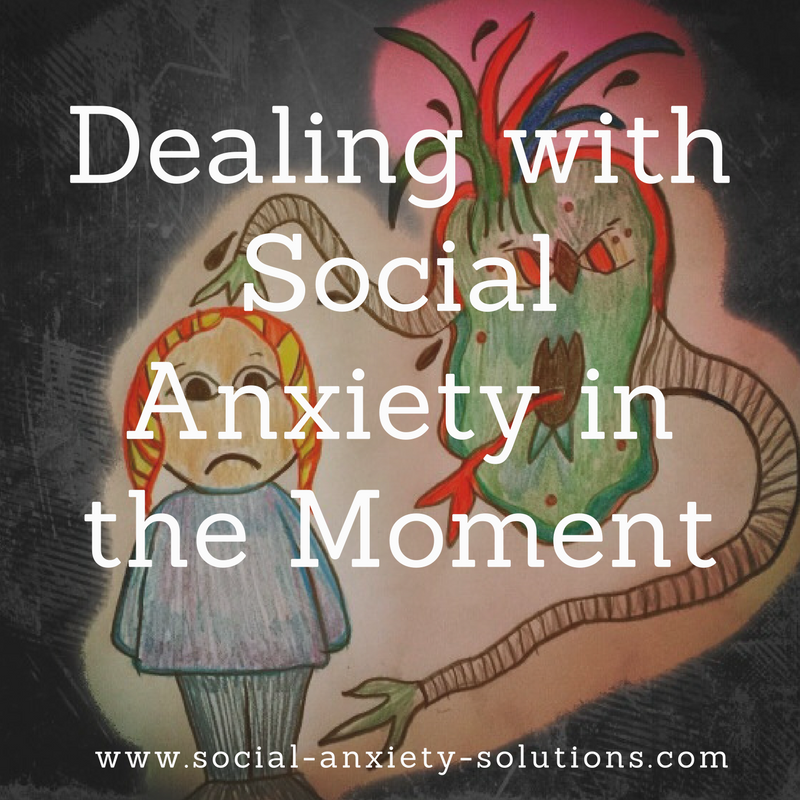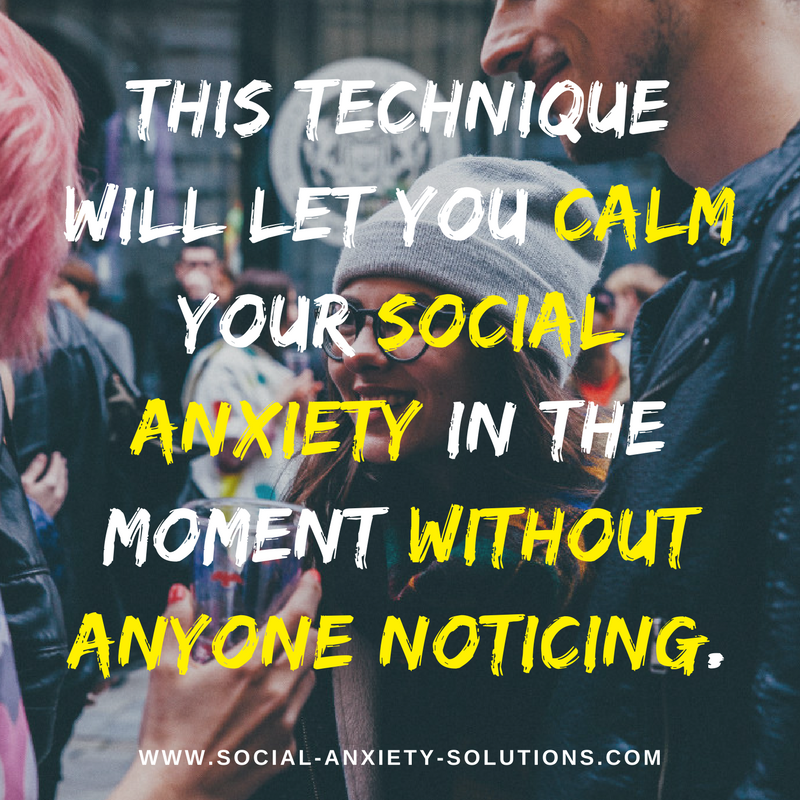SUMMARY
In this post, I answer a viewer question that I’m sure you’ve wondered about as well…
…What to do in the moment of experiencing high anxiety in a social situation.
Something triggers you and…bam! You need to know what to do right then, without bringing even more attention to yourself.
I share the rationale behind a common technique that I haven’t found helpful. And I offer what I have found to be very useful at calming down anxiety.
Of course, you want to continue to heal the root cause of the problem, which you can do in the comfort of your own home and out of the spotlight. But, you can’t put your whole life on hold in the meantime.
Be sure to subscribe above to get the free Starter Kit and upcoming post notifications, to get you on your journey towards social confidence.
And submit your own questions and maybe we will feature it in an upcoming post.




FULL TRANSCRIPTION
Sebastiaan: Hello, this is Sebastiaan from socialanxietysolution.com. I am a personal coach specialized in helping people overcome social anxiety, so you can feel calm and relaxed in social situations.
Now, I had a question sent to me a while ago that I didn’t get to answering yet and I’m gonna answer it now and it is… it’s an interesting question and I think that here in my answer will help you a bit with mindset and understanding. So, here’s the question and just look this up properly.
Alright, it’s a bit of a long question but here we go –
“Hi, Sebastiaan. I watch quite a lot of your videos and also notice that you have knowledge in a lot of different techniques. Maybe you can help me with my question. I’m looking for something I can use in extreme situations to nearly instantly feel safe, confident and relaxed.
I mean unplanned situations where EFT and a lot of other techniques would be too slow to work with in that moment. Situations where you don’t have time to tap for a couple of rounds, it should be something like a trigger. I’ve tried to install when using NLP and even hypnosis but somehow, I could not get it to work. It’s pretty frustrating because I’ve seen various videos where people successfully use such a trigger, so I know this is definitely possible.
I thought maybe you have an idea because you know a lot of stuff, maybe there’s some technique, trick or special way of anchoring I’m not aware of. Of course, it’s cannot replace all the work that has to be done with techniques like EFT to get rid of the deeper causes. I’m just looking for some sort of safety net that could be reliably activated for those really difficult unplanned situations where you just have to function. Maybe you have an idea…” – David
David, good question. And I’ve got bad news for you. I wish there was such a thing, I have not found it. So… And just to give you an idea I am an NLP practitioner, I do Psych-K, Emotion Code, EFT, Logosynthesis. I’m no hypnotist, but I’ve done some mini courses in hypnosis. I’ve studied a wide variety of things and one of the things that David is referring to is anchoring.
A technique I haven’t found useful (of course you still may)
And it’s a typical technique in NLP where you get yourself into a particular good feeling state, maybe you think about the time that you were really successful and you see what you saw back then and you hear what you heard back then and you feel, you get into that good feeling and then right at that moment you make a unique movement. Maybe you do like this or something and then you change your mind, you think about what you’ve eaten you know, two days before or something and then you do it again and you kind of keep going back to that experience, you keep going back to new experiences that were good.
So, you go to positive memories where you felt really good and you kind of stack up that anchor. And then when you’re… Sorry, you kind of stack up that good feeling. So, every time you’re in that good feeling at the height of it – boom, you make that unique movement. It’s a very Tony Robbins like.
And then the idea is that when you’re then in a particular situation, say you’re super anxious, anxiety overcomes you that you then do this and that then all the feelings get activated because they’re neurologically anchored to this particular movement. And that would then cancel out the feelings that you’re experiencing in the moment. That’s the theory behind it.
Well, I have never seen that work, or I’ve not heard of it work. However, that doesn’t mean that it’s not possible, although, I seriously doubt that it is possible.
Let’s just say that. And that is for the simple reason that while that anchor might help you in certain situations, I don’t think it will help you in high anxiety situations. Because in a high anxiety situation as you write you know, those really difficult unplanned situations where you just have to function especially in those moments, you’re actually, your system is facing a threat, a real threat to you, you know, sorry… to your system. It is seen as a real threat.
Your subconscious doesn’t differentiate between the threat of rejection which isn’t the real threat to your survival or the threat of a wild lion about the charge at you. It just responds in the same way – “This is a threat, it’s registered as a threat, we have a standard response for that, let’s activate that response so we’re in survival mode in order to deal with that threat in the best way possible.”
So, you know, that’s like because what you’re looking for is then, “Alright, I’m facing a wild bear let me just do this, so I can feel totally confident and relaxed and feel safe. – No, no, no. You’re not safe, you shouldn’t be relaxed, you should be on the lookout”. That is a natural response, that response is helpful in that moment.
What you can do in the moment
So, I’m afraid I can’t give you a real satisfying answer here. You know, however what you can do, which is a quite a bit more helpful, is to become okay with that response showing up for you. And there’s actually a lot of peace and a lot of comfort in that. That’s actually one of the keys to resolving your anxiety.
Because what the problem is now the anxiety comes up for you, and now on top of that anxiety you feel frustrated and you beat yourself up and you’re like, “Oh, I’m a loser and I should feel this way”. And you have all these judgments on top of it. And when you use the tapping, or any of the other techniques that you might know, to release the emotions about the response and you release the judgments towards yourself – “You know, I’m a loser because I get so anxious. I’m weak because I get so anxious and I shouldn’t get anxious”.
All of these thoughts and feelings are tapping targets to aim it and the more you become okay with the anxiety showing up for you, the less of a problem it is when it actually does show up. And when it then does show up it comes up for you, and then it will go away. Because you’re allowing it, you’re accepting it and then it can come in and it can pass.
Now, there’s still work that you need to do in order to stop it from coming up in the first place, the anxiety I’m talking about. But the acceptance work you know, the acceptance work that you’re doing to get to a place of acceptance of the anxiety response coming up will help the anxiety that does come up already process a lot quicker and you won’t beat yourself up about it so much. And you’ll feel a lot more powerful, you’ll feel a lot more empowered to deal with those kinds of situations.
A technique to calm social anxiety in the moment (and go unnoticed)
Other than that, you know, what you can use which does help a little bit is you can do the finger tapping. So, maybe when you’re in a social situation you don’t really feel like starting to tap on your face, it’s maybe a bit weird and you know, also not very convenient though. That would be a good conversation starter but anyway that’s a different story.
So, you can just tap your fingers. So, there are tapping points on the outside of the thumb right there. And on the inside of the nail bed of your index inside of the nail bed of your ring, inside of nail bed of you… Sorry, this is your middle, this is your ring, this is your baby finger. And it’s really on the nail that that you’re tapping. Let me get closer with this finger. So, right there on the nail. That’s where you’re tapping.
Now, when you have your normal, when you hold your hand like this and you pulled your thumb like that then you can tap with this one on the outside of the thumb and you can fold your head like this and you can just go down the stairs.
Now, I’m not wearing my jacket at the moment but if I was… I could just put my hand in my jacket and I just be tapping like this. Alright, and you can calm down like that or you can… Yeah, I’m tapping right now but you don’t really see it. Or if there’s a table here you know, I can tap under the table. In other words, you can just hide that kind of tapping and it can kind of help you soothe yourself, you can soothe the situation. Now, that might reduce your anxiety a tiny bit.
And this is particularly helpful, or I found it to be helpful when there’s anticipatory anxiety. So, you’re in a situation and you know that you know, your anxiety is kind of coming up and it is coming up for and it’s, it’s getting a bit strong, you can just do this tapping. And that might decrease it a tiny little bit. And then it likely won’t go down any further. And what you can then do is you can simply say, “It’s not safe to let go of this anxiety, it’s dangerous to feel calm and relaxed here. I refuse to let it go”. Just use these three statements and then might just calm you down a little bit more.
Because by saying these three statements you’re actually verbalizing the subconscious resistance to letting go of the anxiety response. You are kind of acknowledging the subconscious perception that there is a threat. And that might just calm me down a bit more.
Other than that best thing you can do in these situations is to be compassionate with yourself and it’s much easier to do this work in the comfort of your home rather than right there in the moment. You know, when you’re in the middle of the battlefield you’re not gonna come up with good solutions to your problems. You know, you’re ducking and you’re diving and you’re making sure you don’t get hit with the bullets but then you know, once you you’ve hit safety you can actually do the work to more properly prepare you for… I want to get… I want to say war, but I don’t want to frame socializing as war although it might to be that way.
When you are actually at ease with yourself socializing is just normal, it’s a comfortable thing. It’s something that you enjoy because in your natural state of being that’s actually how it feels. It feels good, energized.
Alright. So, thank you for your question. And if you have a question, let me know and I might answer it in one of these videos. And if I don’t get back to you immediately on video then just be a bit patience please because it takes a bit of time to make these videos and to get to all the questions.
So, thanks for your question and I will you know, if this is helpful for you I have a ton of videos on YouTube. I release one every Thursday, you can subscribe here somewhere, and I will talk to you next Thursday. Bye for now.
If you experience Social Anxiety, click below to receive the FREE “7 Secrets to Social Confidence” Mini Course!
- How To Stop Worrying - January 17, 2024
- How to Reduce Facial Blushing with EFT Tapping? - June 29, 2023
- Are You Scared to Get Anxious? Here’s how to fix it! - June 16, 2023


